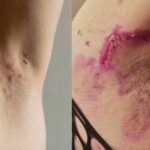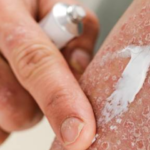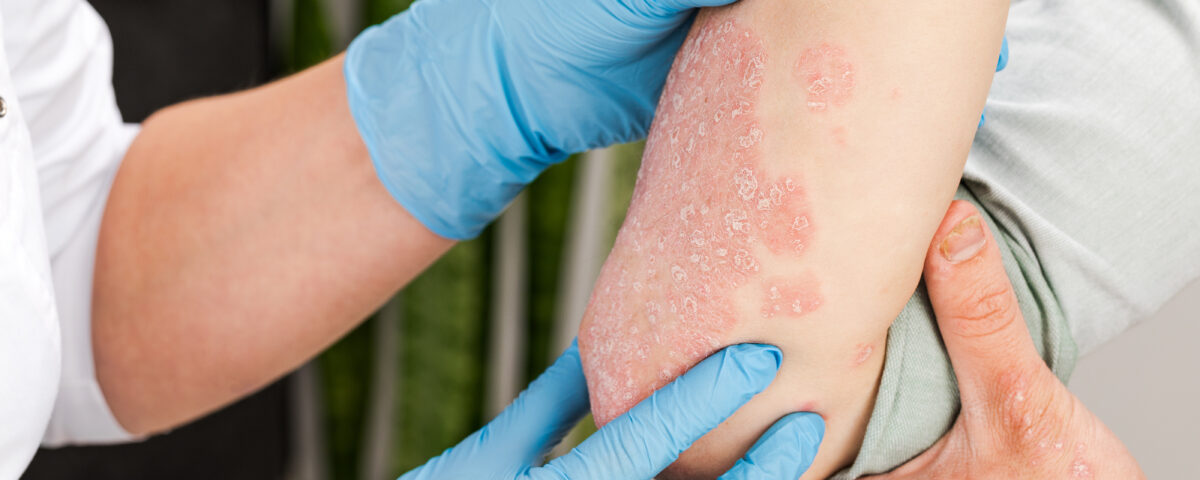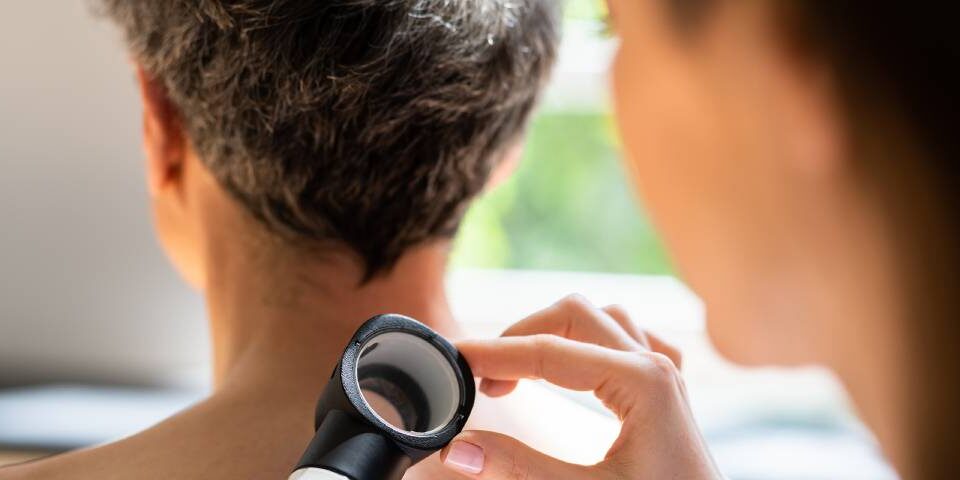
Hidradenitis Suppurativa: Advancing Hope through Clinical Trials
August 5, 2024
Cracking the Code on Eczema Relief: New Treatments for Eczema Clinical Trials
October 10, 2024
A dermatologist wearing gloves examines the skin of a sick patient. Examination and diagnosis of skin diseases-allergies, psoriasis, eczema, dermatitis.
Psoriasis is a painful, itchy skin disease that causes thick, rough, silvery, red, and sometimes purplish rash patches that arise on the elbows, knees, scalp, and trunk. People seeking help with psoriasis often report that these patches itch, sting, and burn. According to the latest statistics, more than 7.5 million Americans struggle with the pain and stigma of psoriasis. There is currently no cure for Psoriasis, which is not contagious, but there are treatments that can help manage and relieve symptoms. The more patients know about psoriasis self-care, the easier it is to manage the condition. Apex Clinical Research Center is also currently running a psoriasis clinical trial to find more effective psoriasis topical treatment options to provide patients with a better quality of life long-term.
What is Psoriasis?
Psoriasis is a chronic, inflammatory skin condition affecting approximately 3% of the population. As a life-long, “immune-mediated” disease, psoriasis is evidence of a malfunctioning immune system. The immune system overreacts to stressors causing T-cells (a type of white blood cell) to trigger inflammation and speed up the production of skin cells leading to the formation of plaques. These large, raised, irritated “plaques” are characteristic of psoriasis and appear especially on the elbows, knees, trunk, scalp, hands, feet, and more. Psoriasis can also affect the joints and internal organs in some of its forms. Scientists are not sure yet what causes psoriasis, but research links it to genetics and some environmental triggers including stress, skin injuries, infections, certain medications, smoking, and high alcohol use.
Is Psoriasis Genetic?
Research indicates that genetics likely plays a role in psoriasis, but again, scientists are still investigating the causes. Other potential triggers include stress, hormones, viral or bacterial infections, obesity, certain medications, skin traumas, sun exposure, diet, and smoking. New psoriasis treatments and lifestyle adaptations for psoriasis self-care are doing a better job of clearing up the symptoms for more and more patients for longer periods, while also reducing the severity and duration of painful flare-ups. The Apex Clinical Research Center psoriasis clinical trial is working to advance psoriasis treatment further to bring hope and relief to more patients.
What Does Psoriasis Look Like?
Psoriasis is characterized by thick, red “plaques” of rough skin with silvery scales forming on the skin. These plaques often form on the trunk, scalp, elbows, knees, ankles, genitalia, palms of the hands, and soles of the feet. Psoriasis afflicts 3.6 percent of Caucasian Americans. It also affects 1.5 percent of African Americans and people of color. However, psoriasis is likely to be underdiagnosed in people of color because of the variations in clinical symptoms.
In skin of color, psoriasis may present with a more purple or hyperpigmented tone with grayish scaling. If psoriasis appears in the groin area or under the breasts, it often appears red and glossy without the scale. Plaques on the hands and feet may not be red, but usually present as white or brown patches with well-defined borders with fissures or cracks.
Types of Psoriasis
Psoriasis is a systemic disease with multiple manifestations in addition to irritating skin plaques. These types of psoriasis include:
Plaque Psoriasis
This is the most common type of psoriasis, affecting 8 out of 10 psoriasis patients, or 6.7 million people over 20. The “plaques” are those rough, scaly, itchy skin patches previously described.
Guttate Psoriasis
About 8 percent of psoriasis cases begin in children or young adults as small, pinkish spots on the skin. On darker skin, the spots may be purple. These spots usually emerge on the trunk, thighs, upper arms, scalp, or thighs. Some cases of guttate psoriasis disappear on their own, but others do not. About one-third of children or young adults with guttate psoriasis will develop plaque psoriasis later on.
Inverse Psoriasis
Inverse psoriasis often emerges in the armpits, under the breasts, in the groin area, or in folds of skin around the buttocks and genitals. It isn’t scaly. Instead, it presents as bright, shiny, smooth red patches that worsen with friction, perspiration, or fungal infections.
Pustular Psoriasis
Pustular psoriasis can be a very serious, chronic condition and requires immediate medical attention. It causes adult patients to have pustules (puss-filled lumps) erupt on the skin. These pustules are surrounded by red or purplish skin. Pustules may emerge on the hands and feet, or the whole body. It may be accompanied by flu-like symptoms such as fever, nausea, chills, fatigue, and an accelerated heart rate. This type of psoriasis may be triggered when stopping or starting medications, too much UV light exposure, infections, stress, pregnancy, or exposure to certain chemicals. Pustular psoriasis also has a few sub-types:
- Von Zumbusch Psoriasis—This type covers large areas of the body and is accompanied by flu-like symptoms and muscle weakness.
- Palmoplantar Pustulosis—The pustules appear on the soles of your feet and/or the palms of your hands.
- Acropustulosis—This rare condition is often triggered by an infection or injury. Pustules appear on the tips of the toes or fingers, especially on the nails.
Erythrodermic Psoriasis
The least common, but most painful and serious type of psoriasis afflicts most of the body with a fiery rash that looks like a severe burn that begins to peel and itch. Body temperature may rise, and heart rate may accelerate. Erythrodermic psoriasis requires immediate medical attention to prevent severe illness or complications such as infections, dehydration, congestive heart failure, or pneumonia. Erythrodermic psoriasis may be triggered by stopping a psoriasis treatment, an allergic reaction to drugs, infections, medications, severe sunburns, alcohol use, trauma, or stress.
How is Psoriasis Diagnosed?
Early and accurate diagnosis is essential for a good outcome with any type of psoriasis. A psoriasis diagnosis includes the following clinical observations:
- A skin exam and biopsy
- Observation of symptoms such as the red, scaly plaques
- Family history of psoriasis
- Medical history involving other associated conditions, including autoimmune disorders and/or arthritis
Common Treatments for Psoriasis
Although there is currently no cure for psoriasis, several conventional treatments do reduce the discomfort, duration, and appearance of the plaques. These include both psoriasis topical treatment modalities, oral medications, and injectables. There are also several lifestyle modifications patients can make to lower inflammation that can provide psoriasis relief.
Psoriasis Topical Treatment Options
Topical treatments for psoriasis are creams and medications that are applied directly to the affected skin to help with psoriasis. Some of these include:
- Topical Steroids—Mild hydrocortisone ointments or other corticosteroid creams, gels, oils, foams, shampoos, sprays, or ointments can help reduce psoriasis inflammation. Your dermatology provider may prescribe a stronger topical steroid for harder-to-treat patches.
- Vitamin D Analogs—Topical, synthetic forms of Vitamin D such as calcipotriene and calcitriol may be used with topical steroids, or on their own. These topical psoriasis creams or ointments can slow the overproduction of skin cells, which can flatten thick, scaly plaques.
- Retinoids—These topical medications are derived from Vitamin A and can be applied as a cream or gel to slow skin cell growth and relieve the inflammation, skin thickening, and scaling associated with psoriasis. These are often contraindicated for patients who are pregnant or breastfeeding.
- Coal Tar—Coal tar topical medications for psoriasis may come in over-the-counter and prescription-strength shampoos, creams, or oils. They reduce inflammation, itchiness, and scaling.
- Salicylic Acid—Found in over-the-counter and prescription psoriasis topical treatment creams, ointments, or shampoos, it acts by chemically peeling the outer layer of skin off. It can help prepare the skin to absorb additional medications.
- Moisturizers—Deeply hydrating moisturizers designed for sensitive skin, without dyes or perfumes, are an important aspect of psoriasis self-care in addition to the medications prescribed by your dermatology provider. Our dermatologists recommend applying moisturizer several times a day, especially after bathing or showering.
Phototherapy
Your dermatology provider may recommend carefully controlled skin exposure to certain bands of ultraviolet light for some types of psoriasis. This may include natural sunshine (UVA and UVB light waves) for short, carefully prescribed periods of time to avoid sunburn and irritation.
In addition to controlled sun exposure, Excimer Lasers that emit high-intensity UVB light into psoriasis plaques can improve the condition after 4 to 10 treatments. Pulsed dye lasers use a different UVB wavelength that kills off blood vessels feeding plaque formation. Between 4 and 6 sessions can clear up a small area. These narrow-band UVB treatments reduce inflammation and slow skin cell turnover.
Systemic Psoriasis Medications
Your dermatology provider may also recommend oral or injectable psoriasis medications to help with larger, more severe flare-ups. This may include steroids and retinoid oral or injectables to address the systemic inflammation.
Biologics and Newer Treatments
Biologics are oral or injectable medications that target specific aspects to disrupt the psoriasis disease cycle at the point of irritation: a dysfunctional immune system. Biologics may be recommended by your dermatology provider when other treatments have not worked. They can calm and soothe psoriasis flare-ups. Some examples include methotrexate, cyclosporin, and acitretin.
Lifestyle Modifications for Psoriasis Self-Care
Several lifestyle modifications can also help with psoriasis self-care because they can help calm inflammatory immune responses and lead to better overall health, which also improves skin health. Some of these important actions include:
- Eat an anti-inflammatory diet rich in fruits, vegetables, whole grains, lean proteins, and healthy fats.
- Stay well hydrated by drinking plenty of water.
- Limit intake of red meat, sugar, dairy, fried foods, refined grains, overly processed foods, and alcohol.
- Soak in a warm tub daily to loosen scales, and always follow with a recommended moisturizer.
- Follow your dermatologist’s sun-exposure recommendations for short bursts of UV rays to reduce inflammation and slow skin cell growth. Remember: too much sun exposure can irritate, burn, and damage the skin, worsening your condition.
- If you smoke, stop.
Limitations of Current Treatments
Although many good psoriasis treatments can improve the quality of life for people with psoriasis, not all of them work for everyone. As with most medications, there are limitations, cautions, and side effects that patients need to be aware of. Psoriasis is a chronic, life-long disease that requires ongoing individual management and evaluation with your healthcare provider to determine the most effective treatments with the fewest drawbacks for your situation.
For example, long-term use of oral or topical steroids can cause the skin to thin too much, and they may stop working if overused. Several other medications mentioned here are not appropriate for young children, for people who are pregnant or breastfeeding, or who may become pregnant. Some may cause nausea, stomach upset, loss of appetite, or other side effects. Coal tar treatments are also messy, staining, and smelly. Many biologics require careful monitoring because they may cause side effects for immunocompromised individuals.
Exploring New Hope through Psoriasis Clinical Trials
Finding better psoriasis treatments to improve our patients' quality of life is exactly why Apex Clinical Research Center is actively working on a psoriasis clinical trial. Clinical trials are a critical tool for helping us find new psoriasis treatments that can work longer-term, with fewer undesirable side effects for a wider range of patients. Those who participate in clinical trials can help lead the way for fellow psoriasis patients to have a better quality of life. If you qualify and choose to participate:
- All study-related care will be covered at no cost to you.
- Compensation may be provided for travel and expenses.
- Health insurance is not required to participate.
Eligibility for the Psoriasis Clinical Trial at Apex Clinical Research Center
Patients who meet the following general criteria may be considered for inclusion in the clinical trial:
- Adults aged 18 and older
- Must be in generally good health
- Have a clinical diagnosis of plaque psoriasis with or without psoriatic arthritis for at least 6 months
Participate in Our Psoriasis Clinical Trial for Help with Psoriasis in Northeast Ohio
If you meet these criteria, please fill out our application form and learn more about the clinical trial. If psoriasis has hurt your quality of life and current treatments have failed to provide the relief and respite you deserve, this may be your first step to a better outcome. You may also help pave the way for many other patients to experience better treatments and long-term relief as well. Apex Clinical Research Center is excited to participate in psoriasis clinical trials to bring more relief to our patients.
If you have any questions, please call us at 440-940-2739, and we will contact you with more information about eligibility and what comes next.




